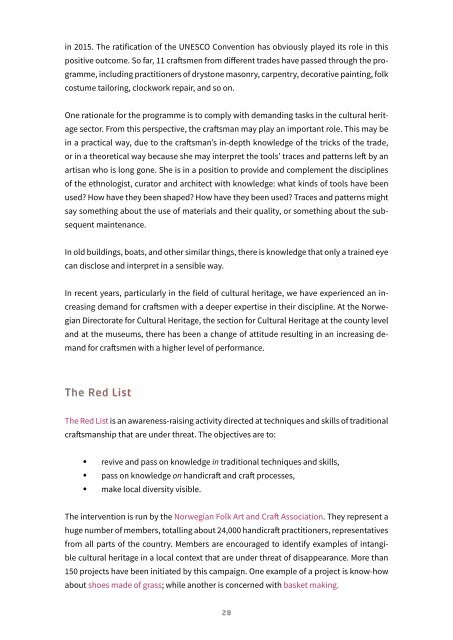Itsetekemisen perinne
8qRV0qs7Z
8qRV0qs7Z
You also want an ePaper? Increase the reach of your titles
YUMPU automatically turns print PDFs into web optimized ePapers that Google loves.
in 2015. The ratification of the UNESCO Convention has obviously played its role in this<br />
positive outcome. So far, 11 craftsmen from different trades have passed through the programme,<br />
including practitioners of drystone masonry, carpentry, decorative painting, folk<br />
costume tailoring, clockwork repair, and so on.<br />
One rationale for the programme is to comply with demanding tasks in the cultural heritage<br />
sector. From this perspective, the craftsman may play an important role. This may be<br />
in a practical way, due to the craftsman’s in-depth knowledge of the tricks of the trade,<br />
or in a theoretical way because she may interpret the tools’ traces and patterns left by an<br />
artisan who is long gone. She is in a position to provide and complement the disciplines<br />
of the ethnologist, curator and architect with knowledge: what kinds of tools have been<br />
used? How have they been shaped? How have they been used? Traces and patterns might<br />
say something about the use of materials and their quality, or something about the subsequent<br />
maintenance.<br />
In old buildings, boats, and other similar things, there is knowledge that only a trained eye<br />
can disclose and interpret in a sensible way.<br />
In recent years, particularly in the field of cultural heritage, we have experienced an increasing<br />
demand for craftsmen with a deeper expertise in their discipline. At the Norwegian<br />
Directorate for Cultural Heritage, the section for Cultural Heritage at the county level<br />
and at the museums, there has been a change of attitude resulting in an increasing demand<br />
for craftsmen with a higher level of performance.<br />
The Red List<br />
The Red List is an awareness-raising activity directed at techniques and skills of traditional<br />
craftsmanship that are under threat. The objectives are to:<br />
• revive and pass on knowledge in traditional techniques and skills,<br />
• pass on knowledge on handicraft and craft processes,<br />
• make local diversity visible.<br />
The intervention is run by the Norwegian Folk Art and Craft Association. They represent a<br />
huge number of members, totalling about 24,000 handicraft practitioners, representatives<br />
from all parts of the country. Members are encouraged to identify examples of intangible<br />
cultural heritage in a local context that are under threat of disappearance. More than<br />
150 projects have been initiated by this campaign. One example of a project is know-how<br />
about shoes made of grass; while another is concerned with basket making.<br />
28


